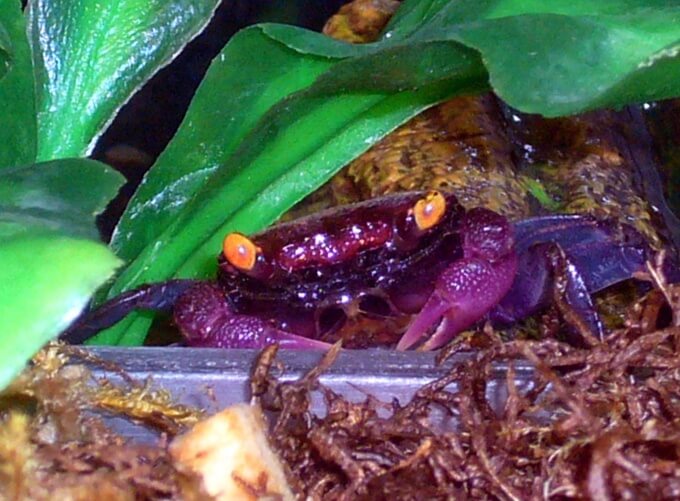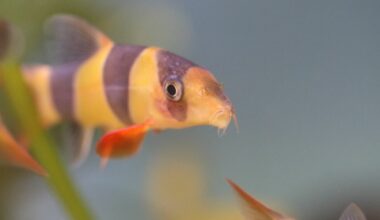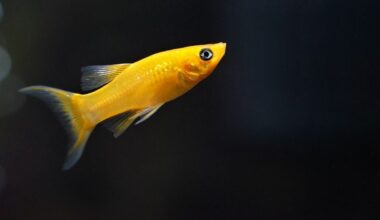
Vampire Crabs are one of the most stunning creatures you can keep in captivity. Their unique colors are something that you need to see to believe!
But if you want one for yourself, there are a few things you should know first. You see, this species has a unique set of care requirements that many potential owners aren’t prepared for.
Don’t worry, we’ve got you covered.
This guide will teach you everything you need to know about Vampire Crab care. You’ll learn about the special tank setup they need, plus a number of facts that you’ll definitely find helpful for ownership!
Quick Facts 
Scientific Name: Geosesarma dennerle
Other Names: Vampire, Geosesarma sb
Lifespan: 2 years
Size: 2 Inches
Care: Easy
Diet: Omnivore
Water Conditions: 70°F-82°F, 7.5-8.0 pH, 0-10 dKH
Tank Size: 10 gallons
Behavior: Vampire Crabs can show quite a bit of aggression toward other creatures.
Breeding Difficulty: High
Table of Contents
Species Summary
If you’re looking for a standout crustacean for your tank, there’s no better choice than the Vampire Crab (Geosesarma dennerle). These aptly named creatures are incredibly mysterious and have a somewhat hazy history.
It’s believed that they have been around the aquarium trade for decades. The only problem was that no one really knew where they came from! That all changed in 2006 when they were officially “discovered.”
Scientifically referred to as Geosesarma Dennerle, these crabs come from small islands in the Indian Ocean. They have been found living in Java, Sulawesi, Riau, and Krakatau. However, they’ve also been distributed throughout Asia and the Western Pacific.
These are unique creatures that are relatively new to the aquarium world. Thus, there’s a lot of misinformation floating around (primarily due to their semi-terrestrial nature). These crabs have some unique care requirements that you must follow to a tee if you want them to stay healthy.
Lifespan
The typical Vampire Crab lifespan is around 2 years at most. This is the same when kept in captivity or in the wild.
As you would expect, their lifespan is determined by several factors. A poorly maintained environment can cause disease and shorten their life expectancy by quite a bit.
Appearance
The most interesting thing about Vampire Crabs is, without a doubt, their appearance! Their profile is similar to that of other small crabs. They have a total of ten legs! This includes their two big pinchers.
While most crabs have powerful claws that can do a lot of damage, that’s not the case with these critters. Their claws are quite small and don’t open up very wide. As a result, you can handle them without having to worry about pinching. That said, they can still harm other small creatures.
When it comes to coloration, Vampire Crabs are one of the most fascinating creatures to observe.
Their bodies are covered in dark purple. The color is brightest on their legs and claws. With some specimens, the claws take on a lighter pink hue.
Typically, the body is a bit darker. It may be brownish-purple or black. Creamy white spots often litter their carapace as well, creating a very stunning look.
That’s not the only interesting thing about these crabs!
On top of their heads, you’ll notice large bright yellow eyes! It’s believed that these crabs got their name due to the foreboding look their eyes and dark purple bodies create.
Males and females look very similar at first glance. However, there are some distinct differences that you can identify. Usually, males are slightly bigger than females. They also often have lighter-colored claws.
If you’re still unsure, you can flip the crab over and take a look at their abdominal flap. Males have thin and somewhat pointed abdominal flaps. Meanwhile, females have a wide oval-shaped flap.
Average Size
The average size of a Vampire Crab is about 2 inches wide. If you want to observe all their beauty you’ll have to get in close!
This measurement includes their leg span. The carapace, which is their main body, is only about an inch wide.
Author Note: Their small size is actually surprising to a lot of people. There’s something about the pictures of these crabs that make them look larger than they are!
Vampire Crab Care
Vampire Crab care doesn’t have to be challenging. Unfortunately, the lack of information about these critters has led to a lot of mistakes by owners.
This species can be quite hardy. But, that’s only true if you’re providing them with the right care.
Vampire Crabs need a perfectly crafted environment to truly thrive. You can’t expect the crabs to live healthy lives with basic decor and substandard water conditions. To help them truly thrive, you’ll need to follow some strict care guidelines.
Author Note: One of the most important things to know about Vampire Crab care is that you’ll be keeping them in a paludarium. We’ll go into that a bit more later on!
Tank Size
The ideal tank size for Vampire Crabs is about 10 gallons. This will offer plenty of room to roam and will allow you to keep half a dozen together without any issues.
You’ll see a lot of owners keeping them in tanks as small as 5 gallons (and care guides recommending this tank size as well). We disagree. Even though these crustacea are very small and don’t need much space, giving them little extra room goes a long way.
Water Parameters
Due to their unique tank setup requirements, there likely won’t be a lot of water for you to maintain (more on that in the section below).
But regardless of how much water you use, it’s still important to stay on top of quality. These crabs require tropical freshwater that’s slightly alkali and pretty warm.
Like many other invertebrates, Vampire Crabs are sensitive to extreme changes in water quality.
You’ll need to perform partial water changes every month. We recommend changing up to 40 percent of the water each time to keep ammonia and nitrate levels low.
To keep your crabs healthy, stick to these parameters:
- Water temperature: 70°F to 82°F (somewhere in the middle is best)
- pH levels: 7.5 to 8.0
- Water hardness: 0 to 10 dKH
Tank Setup
The key to keeping Vampire Crabs healthy is to imitate their natural environment in the wild. This is true with all aquarium creatures. However, it’s pivotal for this species.
As we hinted at earlier, there’s something very different about Vampire Crabs. They are not purely aquatic creatures!
They’re actually considered semi-terrestrial. Because of this, these crabs need a paludarium setup rather than your typical aquarium.
These creatures spend about half of their time on land. So, you’ll need to provide a perch.
Many seasoned Vampire Crab owners recommend a land to water ratio of 80/20. Luckily, that’s not a lot of water in the tank to maintain!
In the wild, you can find these crabs living in dense forest rivers and lakes. Both the land and water portion needs to have a lot of plants.

In fact, these crabs are an excellent addition to terrascaping projects. They don’t eat live plants but will feed on dead ones!
Before you do anything, start with a base of fine sand. Vampire Crabs do like to burrow from time to time. Fine sand is easier to move and won’t cause any damage.
You can use the sand to create a natural elevation for the dry portion. Alternatively, you can use a floating perch or large platform to build the land. Many paludariums have integrated shelves to make this easier.
Plant live plants in both areas. Feel free to experiment with plant varieties as the crabs aren’t particularly fussy about cultivars. You should also introduce driftwood, rocks, and other forms of shelter in the water portion.
Good filtration is a must for the water part of the tank. You can get by with a standard hang-on-back canister filter. However, under-gravel systems do just fine, too.
Author Note: A tank heater and humidifier is a must. Many owners don’t see success with Vampire Crabs because they fail to maintain appropriate humidity levels for the land portion.
You should set your equipment to keep the humidity levels at a constant 75 percent.
Possible Diseases
Not much is known about the diseases that Vampire Crabs can get. They don’t suffer from common issues that fish do. For example, they aren’t affected by Ich (which is quite common). Though, they can carry it and affect your fish.
It’s believed that Vampire Crabs are susceptible to the same general ailments that other freshwater crabs are. This includes bacterial infections, fungal issues, and parasites. Luckily, no species-specific conditions have been identified yet.
The good news is that all of those issues can easily be avoided by just maintaining your tank. In most cases, stress from poor water and quality is the main culprit for diseases.
Food & Diet
Vampire crabs aren’t picky eaters at all. They’re natural omnivores that usually take what they can get in the wild. In their natural habitat, insects and plant detritus are the main choices for food.
The same can be done in your aquarium as well. They do fine with live food like bloodworms, brine shrimp, larvae, and earthworms. However, they can also take dry commercial foods. These critters will chow down on dry flakes, algae wafers, and more without any issues.
We recommend providing some calcium-rich foods as well. Things like spinach, peas, and broccoli are all good choices. These foods will help strengthen their shells!
Behavior & Temperament
These crabs have a very fitting name. They’re largely nocturnal and will spend most of their days hiding away from the light. It’s when the sun goes down that they are truly active.
They will roam the tank and spend time on land and in water. Usually, they will lay motionless in a preferred spot for hours on end. This is completely normal, so don’t be alarmed.
Several times throughout their life, the crabs will also molt. They shed their old shells to make room for new ones. This happens very frequently during the first six months of life. After that, it’s more of a monthly occurrence.
Hiding places are essential for them during the molting phase. Their new shells are not firm after molting. Thus, they’re very vulnerable.
Make sure that they have plenty of plants to hide in. The sandy substrate will also come in handy. Some crabs like to burrow when they molt to stay out of sight.
As for temperament, Vampire Crabs can show quite a bit of aggression toward other creatures.
They do just fine with other Vampire Crabs. However, they will fight and try to eat other species or anything else they feel is encroaching on their territory.
Vampire Crab Tank Mates
The best tank mates for Vampire Crabs are going to be other Vampire Crabs.
In fact, they do best in groups. As we mentioned earlier, fighting others of the same species isn’t too common.
We recommend keeping a single male with two females. This will prevent any aggressive behavior around mating season.
Other appropriate tank mates include large freshwater aquarium snails as well as shrimp (the Cherry is a good option). Be aware that there’s no guarantee of complete safety for these critters, but it will likely work out just fine.
If you plan on creating a small community tank, the goal is to keep things peaceful. Stick with similarly-sized fish or invertebrates.
The other creatures shouldn’t be large enough to eat your crab. They can’t be small enough to be eaten by your Vampire Crabs either.
Small dither fish are good options if you have a lot of space in the tank. These fish should stick towards the bottom of the water column. Their goal is to let the crab no that no predators are around.
You can try Neon Tetras, Zebra Danios, and other peaceful fish species. Just exercise caution and remove the fish if you notice any aggressive behavior from the Vampire Crabs.
Breeding
Because not a lot of information is known about Vampire Crabs, there aren’t any established breeding methods around. In most cases, the creatures will just breed on their own time.
When this happens, the male will get on top of the female to fertilize the eggs. The female will then carry between 20 and 80 eggs for about a month. After they hatch, you’ll notice fully-formed Vampire Crab babies running around.
After birth, they are very independent. Though, some will stick around the mother for a bit.
We recommend removing the babies after they hatch from the eggs. Vampire Crabs can display some cannibalistic behavior. This is even true with the babies. So, you’ll need to ensure that the tank you move them to has plenty of hiding spots for the little crabs to stay safe.
Still Interested?
As you can see, Vampire Crab care is a bit different. Unlike a lot of the other animals you see in the aquarium scene, these semi-terrestrial critters have their own set of rules.
However, their beauty makes it all worthwhile.
If you have any stories, tips, or photos that you’d like to see added to this guide, just let us know! We’re fascinated by these creatures and want to provide the best resource possible.

